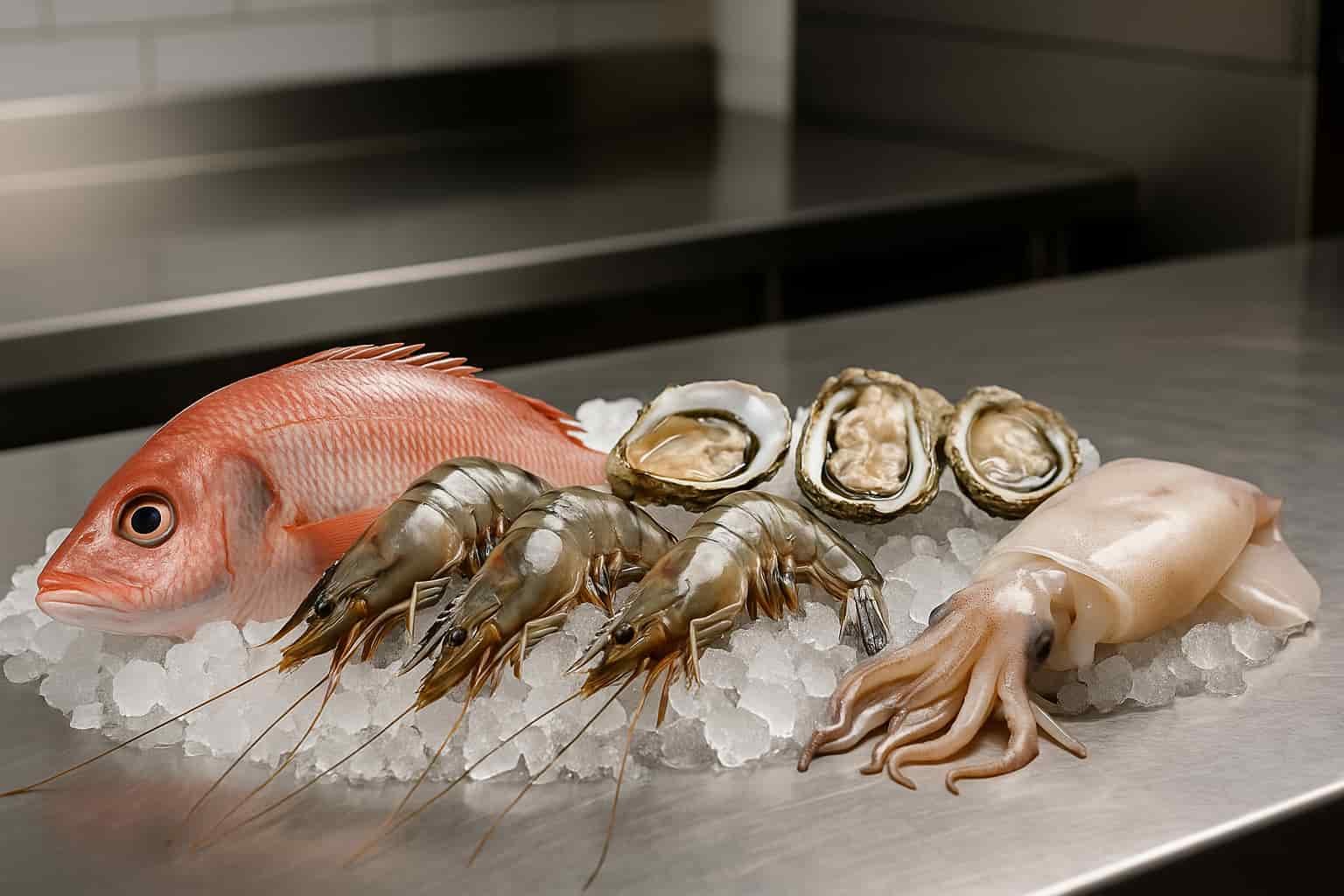Storing fresh seafood correctly is essential to preserve its natural flavor, texture, and nutritional value. Improper storage leads to rapid bacterial growth, spoilage, and significant health risks, including foodborne illnesses like Vibrio and Salmonella infections. According to the U.S. Food and Drug Administration (FDA), perishable seafood must be kept at temperatures below 40°F (4°C) to remain safe for consumption.
This guide provides clear, actionable instructions on how to store various types of fresh seafood, including fish, shellfish, shrimp, and squid. Whether you’re a home cook or a restaurant owner, following these scientifically-backed methods ensures your seafood stays fresh, safe, and ready to deliver optimal taste.
Contents
- 1 What Are the Main Risks of Improperly Storing Fresh Seafood?
- 2 How Should You Store Fresh Fish at Home to Keep It Fresh Longer?
- 3 How to Store Fresh Shellfish Like Oysters, Mussels, and Clams?
- 4 What Is the Best Way to Store Fresh Shrimp and Prawns?
- 5 How Do You Properly Store Fresh Squid, Octopus, and Cuttlefish?
- 6 Can You Use Ice to Store Fresh Seafood, and Is It Safe?
- 7 How to Vacuum Seal Fresh Seafood for Longer Storage?
- 8 Are There Special Storage Tips for Tropical vs Cold-Water Seafood?
- 9 How Can You Tell If Fresh Seafood Has Spoiled Despite Proper Storage?
- 10 How to Prevent Seafood Spoilage During Transportation?
- 11 What Are the Common Mistakes to Avoid When Storing Fresh Seafood?
What Are the Main Risks of Improperly Storing Fresh Seafood?
The main risks of improper seafood storage include bacterial contamination, toxin development, and rapid spoilage. These risks not only degrade the seafood’s quality but also increase the likelihood of serious foodborne illnesses.
- Bacterial Growth: Seafood is highly perishable and prone to bacterial contamination from organisms such as Vibrio vulnificus, Listeria monocytogenes, and Salmonella enterica. Bacterial levels double every 20 minutes at temperatures above 40°F (4°C).
- Toxin Formation: Certain bacteria produce harmful toxins, including histamines in scombroid fish like tuna and mackerel. These toxins remain active even after cooking.
- Structural Degradation: Improper temperature and humidity accelerate enzymatic breakdown, causing a mushy texture and off-odors.
Can Improper Storage Cause Foodborne Illness?
Yes, consuming seafood stored incorrectly leads directly to foodborne illnesses. The FDA reports that seafood accounts for over 20% of foodborne illness outbreaks annually in the United States.
- Common illnesses include:
- Vibrio infections causing diarrhea, vomiting, and abdominal cramps.
- Scombroid poisoning from high histamine levels resulting in skin flushing and headaches.
- Listeriosis, particularly dangerous for pregnant women and immunocompromised individuals.
Does Incorrect Temperature Affect Seafood Quality?
Yes, maintaining incorrect storage temperatures directly degrades seafood quality.
- At 41°F (5°C), bacterial activity slows significantly, extending shelf life by up to 3 days compared to room temperature storage.
- At temperatures above 40°F (4°C), seafood can spoil within 2 to 4 hours, especially in high humidity conditions.
Proper temperature control preserves firmness, natural flavor, and prevents unpleasant odors caused by protein breakdown.
How Should You Store Fresh Fish at Home to Keep It Fresh Longer?
To keep fresh fish longer, store it at a constant temperature of 32°F (0°C) and use moisture-resistant packaging.
- Place the fish on a bed of crushed ice in a sealed container inside the refrigerator.
- Ensure that melted ice water drains away to prevent waterlogging, which damages the fish’s texture.
- Use vacuum-sealed bags if storing for more than 48 hours to limit oxygen exposure and bacterial growth.
What Is the Ideal Temperature to Store Fresh Fish?
The ideal storage temperature for fresh fish is exactly 32°F (0°C). This temperature slows bacterial activity to a minimum without freezing the fish’s delicate tissues.
Should Fresh Fish Be Stored in the Fridge or Freezer?
Store fresh fish in the fridge if you plan to consume it within 1 to 2 days. Use the freezer for storage beyond 48 hours.
- Refrigeration: Maintain at 32°F (0°C) using ice packs.
- Freezing: Set at -4°F (-20°C) to preserve texture and flavor for up to 3 months. Vacuum sealing before freezing prevents freezer burn.
How Long Can Fresh Fish Last in the Refrigerator?
Fresh fish lasts up to 2 days in the refrigerator when stored properly at 32°F (0°C).
If not consumed within this timeframe, freezing is required to maintain safety and quality.
How to Store Fresh Shellfish Like Oysters, Mussels, and Clams?
To store fresh shellfish safely, keep them alive until cooking by maintaining cool temperatures and proper ventilation.
- Store shellfish in a breathable container such as a mesh bag or a bowl covered loosely with a damp cloth.
- Keep the container in the refrigerator at temperatures between 35°F and 40°F (1.6°C to 4.4°C).
- Do not seal live shellfish in airtight containers, as this will suffocate them.
Can You Store Live Shellfish in Water or Ice?
No, live shellfish must never be stored directly in water or ice.
- Submerging shellfish in fresh water causes osmotic shock, killing them within hours.
- Direct contact with ice leads to temperature shock and potential death.
- Instead, place shellfish on top of ice packs or crushed ice, ensuring melted water drains away.
How to Keep Shellfish Alive Until Cooking?
To keep shellfish alive, store them in a cool, moist environment with adequate airflow.
- Wrap them loosely with a damp towel to maintain humidity.
- Avoid stacking heavy items on top to prevent damaging their shells.
- Consume shellfish within 24 to 48 hours to ensure peak freshness and safety.
When Should You Discard Shellfish That Don’t Close Their Shells?
Discard shellfish immediately if their shells remain open and do not close when tapped.
- This indicates the shellfish are dead and unsafe for consumption.
- Always perform a tap test before cooking: live shellfish will close their shells in response to stimulation.
What Is the Best Way to Store Fresh Shrimp and Prawns?
Store fresh shrimp and prawns at 32°F (0°C) on ice or in the coldest part of your refrigerator.
- Keep them in their shells to retain moisture and flavor.
- Place shrimp in a covered container lined with crushed ice.
- Replace the ice daily if storing for longer than 24 hours.
Should You Remove the Shells Before Storing Shrimp?
No, keep shrimp in their shells until you are ready to cook them.
- The shells protect the delicate flesh from oxidation and moisture loss.
- If the shrimp are already peeled, store them in an airtight container and consume within 24 hours.
How Long Can Fresh Shrimp Be Stored Safely?
Fresh shrimp can be stored safely for up to 2 days in the refrigerator at 32°F (0°C).
- If longer storage is needed, freeze them immediately at -4°F (-20°C), where they can last up to 3 months without significant quality loss.
How Do You Properly Store Fresh Squid, Octopus, and Cuttlefish?
To store fresh squid, octopus, and cuttlefish, clean them thoroughly and keep them at temperatures between 32°F and 34°F (0°C to 1.1°C).
- Remove internal organs and rinse the body cavities under cold running water.
- Pat them dry and place them in airtight containers to prevent odor contamination.
- Store in the coldest section of the refrigerator and consume within 24 to 48 hours.
Should You Clean Cephalopods Before Storing?
Yes, cleaning cephalopods before storage prevents rapid spoilage and odor development.
- Remove ink sacs, intestines, and cartilage immediately after purchase.
- Proper cleaning reduces bacterial load and extends freshness.
How to Prevent Odor When Storing Squid and Octopus?
To prevent odor, store squid and octopus in sealed containers and separate them from other foods.
- Use glass or BPA-free plastic containers with tight-fitting lids.
- Adding a layer of paper towel inside the container helps absorb excess moisture, minimizing odor formation.
Can You Use Ice to Store Fresh Seafood, and Is It Safe?
Yes, using ice is a safe and effective method to store fresh seafood if properly managed to avoid direct water contact.
- Place seafood on top of crushed ice in a perforated container to allow drainage.
- Avoid direct ice contact with delicate seafood cuts like fillets to prevent textural damage.
- Replace melted ice regularly to maintain a consistent low temperature of 32°F (0°C).
How Should Ice Be Applied to Maximize Freshness?
Apply ice under and around the seafood without direct prolonged contact with flesh.
- Use crushed ice to ensure even cooling and faster temperature stabilization.
- Line the container with a layer of ice, place seafood on top, and add another thin layer of ice above it.
- Ensure that melted ice water drains effectively to prevent soaking.
Is Direct Contact with Ice Harmful to Seafood Texture?
Yes, prolonged direct contact with ice damages seafood texture, causing mushiness and water absorption.
- Thin fish fillets and shellfish are particularly vulnerable to ice burn and structural breakdown.
- Always separate seafood from direct ice contact using a layer of food-safe plastic wrap or a perforated tray.
How to Vacuum Seal Fresh Seafood for Longer Storage?
To vacuum seal fresh seafood, use a commercial-grade vacuum sealer and freezer-safe vacuum bags to remove air and prevent oxidation.
- Clean and pat dry the seafood before sealing.
- Label each vacuum-sealed bag with the packing date and type of seafood.
- Store vacuum-sealed seafood in the freezer at -4°F (-20°C) to extend shelf life up to 6 months without significant quality loss.
What Are the Benefits of Vacuum Sealing Seafood?
Vacuum sealing extends seafood shelf life by preventing freezer burn, bacterial growth, and moisture loss.
- Increases freezer storage time by up to 4 times compared to conventional packaging.
- Retains original flavor, texture, and nutrient content by minimizing oxygen exposure.
How Long Does Vacuum-Sealed Fresh Seafood Last?
Vacuum-sealed fresh seafood lasts up to 6 months in the freezer at -4°F (-20°C) and up to 7 days in the refrigerator at 32°F (0°C).
- For best quality, consume oily fish like salmon within 3 months, and lean fish such as cod within 6 months.
Are There Special Storage Tips for Tropical vs Cold-Water Seafood?
Yes, tropical and cold-water seafood have different fat content and storage requirements to maintain freshness.
- Tropical Seafood: Requires quicker consumption due to higher susceptibility to spoilage in warmer environments. Store at 32°F (0°C) and consume within 24 to 48 hours. Examples include snapper and grouper.
- Cold-Water Seafood: Has higher fat content, allowing longer refrigeration and freezing times. Store at 32°F (0°C) and freeze if not consumed within 48 hours. Examples include salmon and cod.
Do Tropical Seafood Species Require Different Temperatures?
No, both tropical and cold-water seafood should be stored at the same optimal temperature of 32°F (0°C).
- However, tropical species have a shorter safe storage window due to their biological makeup and faster spoilage rate.
How to Adjust Storage Methods Based on Seafood Origin?
Adjust storage duration, not temperature, based on seafood origin.
- Tropical seafood should be consumed within 24 to 48 hours even under ideal conditions.
- Cold-water seafood can safely remain refrigerated for up to 72 hours before freezing is necessary.
How Can You Tell If Fresh Seafood Has Spoiled Despite Proper Storage?
You can identify spoiled seafood through specific visual, olfactory, and textural signs that indicate degradation.
- Even when stored under optimal conditions, seafood naturally deteriorates after its maximum shelf life.
- Conduct a thorough inspection before cooking, focusing on appearance, smell, and texture to ensure safety.
What Are the Visual Signs of Spoiled Seafood?
The primary visual signs of spoiled seafood include discoloration, excessive slime, and sunken or cloudy eyes (for whole fish).
- Discoloration: Look for dull, faded colors or brownish and grey patches on fish fillets.
- Slime Formation: An unusually thick, sticky layer on the surface signals bacterial growth.
- For whole fish: Cloudy eyes and sunken gills indicate spoilage.
Can You Detect Spoilage Through Smell and Texture?
Yes, spoiled seafood produces a strong, unpleasant odor and develops a soft, mushy texture.
- Smell: Fresh seafood should have a mild, ocean-like scent. A sour, ammonia-like, or overly “fishy” smell indicates spoilage.
- Texture: Press the flesh gently; if it does not spring back and feels overly soft or slimy, the seafood is no longer fresh.
How to Prevent Seafood Spoilage During Transportation?
To prevent spoilage during transportation, maintain a continuous cold chain at or below 32°F (0°C) using insulated containers and adequate ice packs.
- Use FDA-approved insulated coolers with sufficient ice or gel packs to preserve low temperatures.
- Ensure proper ventilation to avoid moisture accumulation inside the container.
- Limit transportation time to under 2 hours if ice is not continuously replenished.
What Packaging Materials Are Best for Transporting Fresh Seafood?
Use food-grade insulated containers, vacuum-sealed packaging, and moisture-resistant liners for optimal protection.
- Polystyrene boxes with drainage holes are ideal for maintaining ice placement and draining meltwater.
- Vacuum-sealed packaging prevents oxidation and cross-contamination during transit.
How to Maintain Cold Chain Integrity During Long-Distance Shipping?
Utilize refrigerated trucks or air cargo services equipped with temperature monitoring systems for long-distance shipping.
- Include data loggers to track temperature throughout transit.
- Use dry ice for frozen products and gel ice packs for fresh seafood to maintain consistent temperatures.
What Are the Common Mistakes to Avoid When Storing Fresh Seafood?
The most common mistakes in storing fresh seafood include improper temperature control, inadequate packaging, and storing different seafood types together.
- Incorrect Temperature: Storing seafood above 40°F (4°C) accelerates bacterial growth and spoilage.
- Poor Packaging: Using non-airtight or absorbent materials leads to moisture loss and contamination.
- Mixing Seafood Types: Storing shellfish with fish or cephalopods can lead to cross-contamination and faster spoilage due to varying moisture and bacterial levels.



